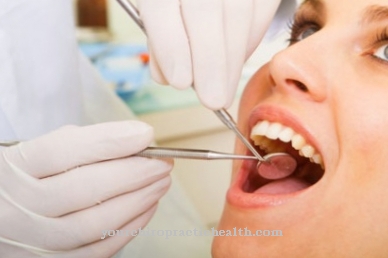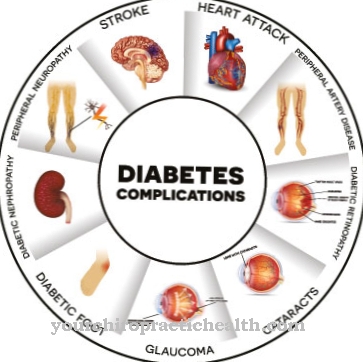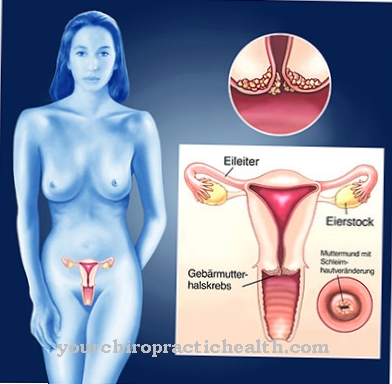The actinic keratosis or solar keratosis is a slowly progressing skin damage due to years of exposure to light (especially UV light). In the following, the definition, causes, diagnosis, course, therapy and prevention of actinic keratosis are explained.
What is actinic keratosis?

This results in damage to the cornified epidermis. Actinic keratosis often takes several years to develop after damage has occurred. Actinic keratosis is considered a precancerous condition, which means that skin cancer can develop after years.
Actinic keratosis is a precancerous condition with a tendency to malignant degeneration in 5 - 10% of cases. Actinic keratosis is therefore also regarded as carcinoma in situ, i.e. an early stage of a tumor without invasive growth and the formation of one or more malignant secondary tumors in other organs.
causes
Actinic keratosis occurs mainly in people with skin types I and II. However, men are more often affected than women. The reason for this is often the prolonged occupational time under the rays of the sun for road and construction workers or farm workers or seafarers.
The incidence of actinic keratosis (number of new cases) is increasing in Germany because hobbies such as water sports, tennis, hiking or skiing as well as trips to countries with a higher proportion of UV rays are increasing.
The latency period of actinic keratosis until the onset of visible skin damage can last up to 20 years. In the meantime, the DNA of the skin cells is damaged (mutation). Gradually, the mutated skin now multiplies and displaces normal skin.
Symptoms, ailments & signs
Actinic keratosis manifests itself as superficial changes in the skin in areas of the body that are often exposed to sunlight - especially the face, forehead, head and forearms. Small reddish spots develop on these parts of the body, which in the course of the disease develop into sharply defined reddish nodules that are about the size of a lentil and are gray-brown keratinized. The skin feels rough in the affected area.
With pronounced cornification, small horns of the skin can form, which cause pressure pain. The skin changes usually occur over a large area on the entire body or in small groups on certain parts of the body.In the later stages, actinic keratosis may also manifest itself in the form of hardening, bleeding and reddening of the affected skin. In addition, the lesions increase in size and sometimes develop into ulcers.
Pain or excessive keratinization of the skin and itching can also occur, particularly if actinic keratosis develops into skin cancer. If a spinalium has already formed, further symptoms such as sensory disturbances and paralysis can occur in the affected area. Ultimately, extensive skin changes occur, in the course of which the skin flakes and hardens further.
Diagnosis & course
Actinic keratosis develops preferentially on the head and arms, i.e. body regions that are increasingly exposed to UV light. The so-called "sun terraces of the face" are forehead, nose, ear, mouth and, in men, the bald head. But also forearms and backs of the hands often develop actinic keratosis.
Before actinic keratosis develops, reddish discoloration of the skin (round, oval) occurs individually or in several places. As a rule, these discolorations have a rough surface. As described above, the mutated skin displaces the normal skin and a brown, thickened keratosis develops, which can vary in thickness.
One form of actinic keratosis is the cutaneous cornu. In the process, a very strongly changed skin is formed that looks like a horn. Five to ten percent of patients with actinic keratosis develop a malignant tumor when the basement membrane of the skin is broken.
Often this is an invasive squamous cell carcinoma. If the patients are also immunocompromised, the proportion of malignant degeneration of actinic keratosis is increased in up to 30% of cases. The development of a malignant degeneration often takes years.
Actinic keratosis is usually suspected on the basis of its clinical appearance and characteristics. The professional or private situation is also discussed. However, the final diagnosis of actinic keratosis can only be made through a histological examination after a biopsy.
Complications
Actinic keratosis can be treated very effectively in the early stages. The treatment options - such as cryo, laser, or cutting out the focus - are usually without complications. Treatment may result in minor injuries that bleed a little and heal over the course of a few days. If actinic keratosis is not treated, the keratosis can develop into a spinalioma.
This sub-form of white skin cancer is much more difficult to treat and more complicated than actinic keratosis. White skin cancer develops in around ten percent of all cases of untreated actinic keratoses. The spinalioma breaks out about ten years after the first spot appears on the skin, which can be attributed to actinic keratosis.
Spinaliomas tend to grow deep into the tissue and proliferate there. Spinaliomas often form metastases, initially in the surrounding lymph nodes, then mainly in the lungs. Actinic keratosis shows up in the early stages in the form of white spots, mainly on the face and hands.
If left untreated, the spots remain, which can have a negative effect on the psyche in particularly sensitive people. Withdrawal and social isolation are often the result.
When should you go to the doctor?
In many cases this disease is diagnosed relatively late, which can lead to irreversible consequential damage. For this reason, a doctor should always be consulted if skin complaints occur that are unusual and do not go away on their own. There is no spontaneous healing in this disease. A visit to the doctor is usually necessary if there are extensive changes on the skin. Different areas of the body can be affected by these changes.
The face is also often affected by the skin complaints. Furthermore, these complaints can lead to inferiority complexes or to depressive moods, whereby a psychologist can be consulted. Medical treatment is also necessary in the case of papules or keratinization of the skin. The earlier this treatment is started, the lower the risk of serious consequences. As a rule, a dermatologist can be contacted directly who can properly treat the symptoms. In acute emergencies, the patient should go to the hospital.
Doctors & therapists in your area
Treatment & Therapy
Actinic keratosis is treated on the one hand by removing the foci by curettage (scraping or scraping), excision (cutting out) or cryotherapy (cold therapy). Electrosurgical or laser treatment is also possible.
On the other hand, local drugs can also be used to treat actinic keratosis. Photodynamic therapy can also be used for larger, extensive forms of actinic keratosis. Light is used in combination with a photosensitizer (light-active substance) and oxygen present in the tissue.
The substance to be applied is primarily non-toxic to the body, but stimulation with light in a certain wavelength and oxygen create reactive toxic substances that damage the regions of actinic keratosis. As a rule, photodynamic therapy is scar-free.
Outlook & forecast
This disease causes severe damage to the skin. The damage usually occurs continuously through various exposures, so that the symptoms in most cases only appear and become apparent later in life. There are changes in the complexion of the skin in various places.
Changes in the face are particularly uncomfortable for the patient. In some cases, those affected then suffer from reduced self-esteem. Pain can also occur in the affected regions, which can make everyday life difficult. The skin is red and may be covered with papules.
As a rule, the quality of life is reduced by this disease and the skin is relatively rough. Furthermore, various types of cancer can occur if the skin has been severely damaged.
The disease can be treated by removing the affected areas of the skin. In most cases there is no scarring. However, the affected person must then protect their skin from direct sunlight.
prevention
The prophylaxis or prevention of actinic keratosis consists in consistent light protection. This should be done especially in childhood, as a latency period of 10 to 20 years is known. This is especially true for people with skin types I and II, as these are particularly at risk.
Aftercare
The local treatment of actinic keratosis with ointments or gels is usually associated with severe inflammatory changes in the treated skin area. Depending on the type and mode of action of the drug used, this lasts for some time after the end of the treatment: As part of aftercare, it is important to keep the affected skin areas clean and to avoid skin irritation from clothing or excessive contact if possible.
In general, after consultation with the doctor, a healing ointment containing the active ingredient panthenol may be applied to accelerate the rebuilding of the skin. Products containing cortisone should not be used because they would neutralize the inflammatory process required for the treatment of actinic keratosis. If the skin changes are removed with the help of cryotherapy or surgically, small wounds also remain, which must be protected from contamination and kept dry until they have healed.
The most important aftercare measure is the lifelong sun protection of all endangered skin areas through appropriate clothing and sunscreens with a high sun protection factor. To protect the particularly sensitive skin of the head and face, those affected should always wear a sun hat or a cap when the sun is shining. Regular self-checks of the skin and biannual to annual checkups by the dermatologist ensure that newly occurring actinic keratoses can be treated at an early stage
You can do that yourself
Actinic keratosis does not usually cause severe symptoms and is not acutely dangerous, but it is nonetheless an early form of skin cancer, which is why those affected should definitely consult a specialist.
Since the disease is triggered by UV radiation from the sun or in the solarium, it can be prevented by taking preventive measures. A whole range of protective measures are easy to implement. In particular, people with light skin type I, who are particularly at risk, should never expose themselves to the summer sun for long periods of time without sun protection. Sunscreens should have at least a sun protection factor of 30 and a UVA / UVB broadband filter.
Extensive sunbathing increases the risk despite protective agents. Since solar radiation is particularly intense on the water and in the high mountains, people who have already developed the first signs of actinic keratosis should avoid such situations or take additional precautionary measures. In these cases, affected parts of the body must not only be covered with sunscreen, but also with clothing.
If the attending physician recommends therapy with an immunomodulator, it is imperative that the patient applies the active ingredient to the skin for several weeks as prescribed by the doctor before going to bed. Inconsistent use of an immunomodulator can jeopardize the success of the therapy.













.jpg)

.jpg)
.jpg)











.jpg)